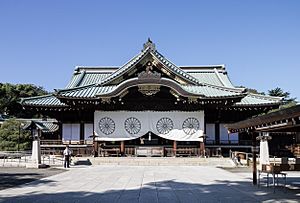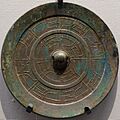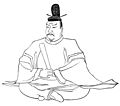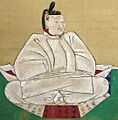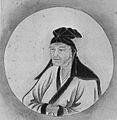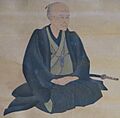History of Shinto facts for kids
Shinto is a special religion from Japan that has been around for hundreds of years. It has changed and grown with many different influences.
Historians aren't sure exactly when Shinto became a separate religion. But we know that people in Japan started honoring kami (which are spirits or gods) way back in the Yayoi period (from 300 BC to AD 300). Later, Buddhism came to Japan around the end of the Kofun period (AD 300 to 538) and quickly became popular.
Over time, the worship of kami and Buddhism became very closely linked. This mix was called shinbutsu-shūgō. People started to see kami as part of Buddhist cosmology (the Buddhist view of the universe). The kami were also shown more and more in human-like forms. The first written stories about kami worship were put down in the 8th century in books called Kojiki and Nihon Shoki.
In the centuries that followed, Japan's Imperial family (the emperor's family) also adopted shinbutsu-shūgō. However, during the Meiji era (1868 to 1912), Japan's leaders wanted to strengthen the country. They removed Buddhist influences from kami worship and created State Shinto. Some historians believe this was when Shinto truly became a distinct religion. Shrines became more controlled by the government, and people were encouraged to worship the emperor as a kami. When the Japanese Empire grew in the early 1900s, Shinto spread to other parts of East Asia. After Japan lost World War II, Shinto was officially separated from the government.
Even experts don't fully agree on what Shinto is or when its history truly began. Some scholars say that the "origin" of Shinto was completed between the Yayoi period and the Kofun period. However, they note that it's not clear when Shinto became a fully organized system.
Contents
What is Shinto?
Shinto is Japan's native religion. It focuses on the worship of kami, which are spirits or gods. These kami can be found in nature, like mountains, rivers, trees, and rocks. They can also be spirits of important people or ancestors. Shinto does not have a single founder or a strict set of rules like some other religions. Instead, it's more about traditions, rituals, and a deep respect for nature and purity.
Ancient Roots of Shinto
While there's no single starting point for Shinto as a religion, its roots go back to ancient Japan.
Early Beliefs and Nature Worship
Around the end of the Jōmon period and the start of the Yayoi period, people in Japan began growing rice. This led to a strong connection with nature. They started to believe that nature itself had a divine spirit. This idea, called nature worship, spread across the Japanese archipelago.
First Shrines and Rituals
During the Kofun period, the Yamato Kingship (an early ruling family) helped spread these beliefs as national festivals. Rituals were held at the first Shinto shrines, such as Munakata Taisha and Ōmiwa Shrine. This is where the basic form of Shinto began to take shape.
Developing Rituals and Mythology
In the Asuka period, the system of rituals, shrines, and ceremonies became more organized. The government's Department of Divinities played a role in managing these rituals. Later, in the Nara period, important books like the Kojiki and Nihon Shoki were written. These books collected Japanese mythology and connected the rituals to the Emperor's family.
During the Heian period, the emperor and his close helpers became more directly involved in local shrine rituals, sometimes without going through the Shinto priests. This period also saw the mixing of Shinto beliefs with Buddhism, known as Shinbutsu-shūgō. However, there were also ideas about keeping Shinto rituals separate from Buddhism, called Shinbutsu bunri. Other beliefs like Shugendō (mountain asceticism) and Onmyōdō (a mix of natural science and occultism) also influenced Shinto.
Shinto in the Middle Ages
The Middle Ages in Japan saw Shinto beliefs become more widespread and organized.
Protecting Shrines and Popular Worship
In the Kamakura period, the Kamakura shogunate (a military government) helped protect shrines across different regions. Among ordinary people, the worship of kami like Kumano, Hachiman, Inari, Ise, and Tenjin became very popular throughout the country.
Interpreting Shinto with Buddhist Ideas
As Shinto spread, educated people started to explain Shinto using Buddhist ideas. For example, some Buddhist monks developed the Honji Suijaku theory. This idea suggested that Shinto gods were actually different forms or "incarnations" of Buddha.
Shinto's Own Doctrines
Shinto shrines felt that their beliefs were being overshadowed. After Japan successfully fought off the Mongol invaders, Shinto gained more importance. Shinto leaders then developed their own version of the Honji Suijaku theory, which placed their kami above Buddha. This led to the creation of Ise Shinto, which used special texts called the Five Books of Shinto.
Later, during the Muromachi period, a priest named Yoshida Kanetomo created the first Shinto theory that was completely separate from Buddhism. This was called Yoshida Shintō. It had its own teachings, scriptures, and rituals. From the Sengoku era to the Azuchi-Momoyama period, Yoshida Shinto was involved in building shrines for powerful feudal lords who were worshipped as gods.
Shinto in Early Modern Japan
The Edo period was a long time of peace and stability in Japan.
Shrine Administration and Pilgrimages
The Tokugawa shogunate (the government during the Edo period) reorganized how shrines were managed. With better safety and transportation, many ordinary people were able to make pilgrimages to important places like Ise Grand Shrine.
New Influences: Confucianism and Kokugaku
During this time, Buddhism, which had been very powerful, started to become less influential as an ideology. Shinto began to connect more with Confucianism, especially the teachings of the Cheng-Zhu school. This led to Confucian Shinto, which combined Shinto beliefs with Confucian ethics.
In the middle of the Edo period, a new movement called Kokugaku (National Learning) became popular. This movement focused on studying Japanese classics, poetry, and language, and it integrated these studies with Shinto. A famous Kokugaku scholar named Motoori Norinaga strongly disagreed with interpreting Shinto through Chinese Buddhist or Confucian ideas. He believed in studying Shinto texts directly.
Fukko Shinto and Mito Studies
Later in the Edo period, Motoori Norinaga's ideas influenced Fukko Shinto (Restoration Shinto). This movement emphasized the afterlife and even suggested that myths from other cultures (like Chinese, Hindu, and Christian myths) were related to Japanese mythology. Fukko Shinto played a role in the later return of power to the emperor.
At the same time, in the Mito Domain, a different school of thought called Late Mito Studies developed. This combined Confucian ethics (like loyalty and respect for parents) with national studies. Late Mito Studies argued that the emperor should rule Japan by combining Confucianism and Shinto. These ideas became important for the Shishi, who were activists at the end of the Edo period who wanted to restore imperial rule.
Shinto in Modern Times
When the old government was overthrown and Japan entered the Late modern period, the new government aimed to unite Shinto and politics.
Separation of Shinto and Buddhism
The new government issued the Great Decree of Restoration of the Monarchy. This led to the Shinbutsu bunri, which formally separated Shinto and Buddhism. In some cases, this even resulted in the Haibutsu kishaku, where Buddhist temples and statues were destroyed.
State Shinto and Its End
The Meiji government then created the State Shinto system. Under this system, the government controlled shrines as state religious services. Later, the idea of "non-religious shrines" was adopted. This meant that shrines were seen as public places, not religions, and local shrines no longer received public money.
In response, Shinto priests formed the National Association of Priests. They wanted to restore the power of Shinto priests and asked the government for public funding. After World War II, the Shinto Directive from the GHQ (the Allied occupation forces) ended the State Shinto system. This system was seen as a root of nationalism. Shrines then became religious corporations, with the Association of Shinto Shrines as their main organization.
Even though shrines lost their official government position in modern times, some have become very successful through their religious activities. Shinto continues to play an important role in Japan's annual events and life rituals.
Images for kids
-
A scene from the medieval Gion Festival depicted in National Treasure (Japan), Yonezawa City Uesugi Museum, by [[Kanō Eitoku
-
Mandala of Hiyoshi Sanno-gu (Muromachi period). The upper part of the mandala shows the deities, main deities, and seeds of the 21 shrines. The lower part is a bird's-eye view of the 21 Sanno shrines, depicting the two shrines at the top of Hachioji Mountain and the group of shrines at the foot of the mountain.
-
Yoshida Shrine in Sakyo-ku Kyoto City


